Yuanzhi Wang
Multi-Modal Hypergraph Enhanced LLM Learning for Recommendation
Apr 13, 2025



Abstract:The burgeoning presence of Large Language Models (LLM) is propelling the development of personalized recommender systems. Most existing LLM-based methods fail to sufficiently explore the multi-view graph structure correlations inherent in recommendation scenarios. To this end, we propose a novel framework, Hypergraph Enhanced LLM Learning for multimodal Recommendation (HeLLM), designed to equip LLMs with the capability to capture intricate higher-order semantic correlations by fusing graph-level contextual signals with sequence-level behavioral patterns. In the recommender pre-training phase, we design a user hypergraph to uncover shared interest preferences among users and an item hypergraph to capture correlations within multimodal similarities among items. The hypergraph convolution and synergistic contrastive learning mechanism are introduced to enhance the distinguishability of learned representations. In the LLM fine-tuning phase, we inject the learned graph-structured embeddings directly into the LLM's architecture and integrate sequential features capturing each user's chronological behavior. This process enables hypergraphs to leverage graph-structured information as global context, enhancing the LLM's ability to perceive complex relational patterns and integrate multimodal information, while also modeling local temporal dynamics. Extensive experiments demonstrate the superiority of our proposed method over state-of-the-art baselines, confirming the advantages of fusing hypergraph-based context with sequential user behavior in LLMs for recommendation.
Distribution Prototype Diffusion Learning for Open-set Supervised Anomaly Detection
Feb 28, 2025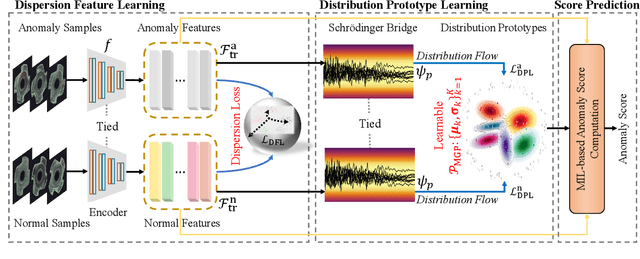
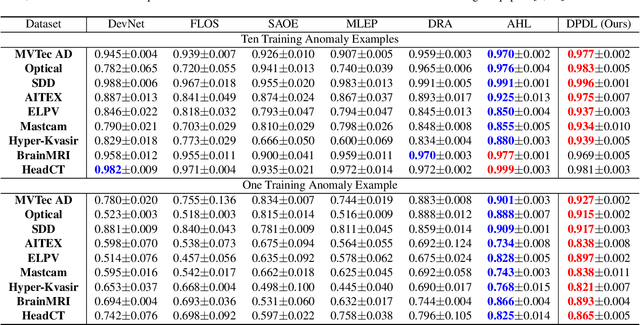
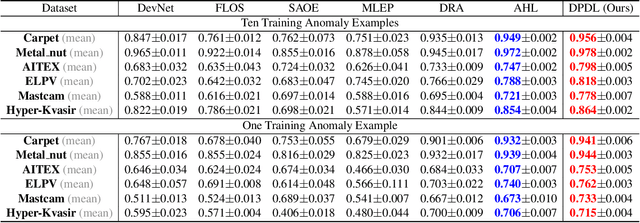
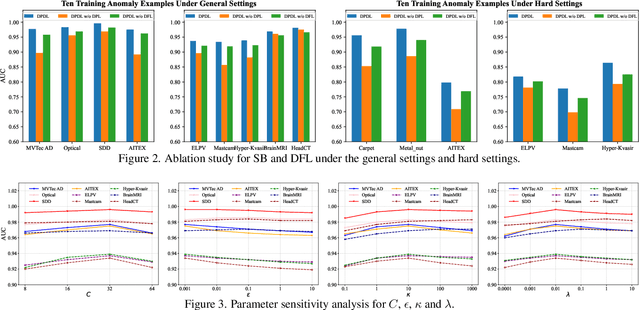
Abstract:In Open-set Supervised Anomaly Detection (OSAD), the existing methods typically generate pseudo anomalies to compensate for the scarcity of observed anomaly samples, while overlooking critical priors of normal samples, leading to less effective discriminative boundaries. To address this issue, we propose a Distribution Prototype Diffusion Learning (DPDL) method aimed at enclosing normal samples within a compact and discriminative distribution space. Specifically, we construct multiple learnable Gaussian prototypes to create a latent representation space for abundant and diverse normal samples and learn a Schr\"odinger bridge to facilitate a diffusive transition toward these prototypes for normal samples while steering anomaly samples away. Moreover, to enhance inter-sample separation, we design a dispersion feature learning way in hyperspherical space, which benefits the identification of out-of-distribution anomalies. Experimental results demonstrate the effectiveness and superiority of our proposed DPDL, achieving state-of-the-art performance on 9 public datasets.
Re-Attentional Controllable Video Diffusion Editing
Dec 16, 2024Abstract:Editing videos with textual guidance has garnered popularity due to its streamlined process which mandates users to solely edit the text prompt corresponding to the source video. Recent studies have explored and exploited large-scale text-to-image diffusion models for text-guided video editing, resulting in remarkable video editing capabilities. However, they may still suffer from some limitations such as mislocated objects, incorrect number of objects. Therefore, the controllability of video editing remains a formidable challenge. In this paper, we aim to challenge the above limitations by proposing a Re-Attentional Controllable Video Diffusion Editing (ReAtCo) method. Specially, to align the spatial placement of the target objects with the edited text prompt in a training-free manner, we propose a Re-Attentional Diffusion (RAD) to refocus the cross-attention activation responses between the edited text prompt and the target video during the denoising stage, resulting in a spatially location-aligned and semantically high-fidelity manipulated video. In particular, to faithfully preserve the invariant region content with less border artifacts, we propose an Invariant Region-guided Joint Sampling (IRJS) strategy to mitigate the intrinsic sampling errors w.r.t the invariant regions at each denoising timestep and constrain the generated content to be harmonized with the invariant region content. Experimental results verify that ReAtCo consistently improves the controllability of video diffusion editing and achieves superior video editing performance.
MMM-RS: A Multi-modal, Multi-GSD, Multi-scene Remote Sensing Dataset and Benchmark for Text-to-Image Generation
Oct 26, 2024



Abstract:Recently, the diffusion-based generative paradigm has achieved impressive general image generation capabilities with text prompts due to its accurate distribution modeling and stable training process. However, generating diverse remote sensing (RS) images that are tremendously different from general images in terms of scale and perspective remains a formidable challenge due to the lack of a comprehensive remote sensing image generation dataset with various modalities, ground sample distances (GSD), and scenes. In this paper, we propose a Multi-modal, Multi-GSD, Multi-scene Remote Sensing (MMM-RS) dataset and benchmark for text-to-image generation in diverse remote sensing scenarios. Specifically, we first collect nine publicly available RS datasets and conduct standardization for all samples. To bridge RS images to textual semantic information, we utilize a large-scale pretrained vision-language model to automatically output text prompts and perform hand-crafted rectification, resulting in information-rich text-image pairs (including multi-modal images). In particular, we design some methods to obtain the images with different GSD and various environments (e.g., low-light, foggy) in a single sample. With extensive manual screening and refining annotations, we ultimately obtain a MMM-RS dataset that comprises approximately 2.1 million text-image pairs. Extensive experimental results verify that our proposed MMM-RS dataset allows off-the-shelf diffusion models to generate diverse RS images across various modalities, scenes, weather conditions, and GSD. The dataset is available at https://github.com/ljl5261/MMM-RS.
Edit Temporal-Consistent Videos with Image Diffusion Model
Aug 17, 2023



Abstract:Large-scale text-to-image (T2I) diffusion models have been extended for text-guided video editing, yielding impressive zero-shot video editing performance. Nonetheless, the generated videos usually show spatial irregularities and temporal inconsistencies as the temporal characteristics of videos have not been faithfully modeled. In this paper, we propose an elegant yet effective Temporal-Consistent Video Editing (TCVE) method, to mitigate the temporal inconsistency challenge for robust text-guided video editing. In addition to the utilization of a pretrained 2D Unet for spatial content manipulation, we establish a dedicated temporal Unet architecture to faithfully capture the temporal coherence of the input video sequences. Furthermore, to establish coherence and interrelation between the spatial-focused and temporal-focused components, a cohesive joint spatial-temporal modeling unit is formulated. This unit effectively interconnects the temporal Unet with the pretrained 2D Unet, thereby enhancing the temporal consistency of the generated video output while simultaneously preserving the capacity for video content manipulation. Quantitative experimental results and visualization results demonstrate that TCVE achieves state-of-the-art performance in both video temporal consistency and video editing capability, surpassing existing benchmarks in the field.
Decoupled Multimodal Distilling for Emotion Recognition
Mar 24, 2023



Abstract:Human multimodal emotion recognition (MER) aims to perceive human emotions via language, visual and acoustic modalities. Despite the impressive performance of previous MER approaches, the inherent multimodal heterogeneities still haunt and the contribution of different modalities varies significantly. In this work, we mitigate this issue by proposing a decoupled multimodal distillation (DMD) approach that facilitates flexible and adaptive crossmodal knowledge distillation, aiming to enhance the discriminative features of each modality. Specially, the representation of each modality is decoupled into two parts, i.e., modality-irrelevant/-exclusive spaces, in a self-regression manner. DMD utilizes a graph distillation unit (GD-Unit) for each decoupled part so that each GD can be performed in a more specialized and effective manner. A GD-Unit consists of a dynamic graph where each vertice represents a modality and each edge indicates a dynamic knowledge distillation. Such GD paradigm provides a flexible knowledge transfer manner where the distillation weights can be automatically learned, thus enabling diverse crossmodal knowledge transfer patterns. Experimental results show DMD consistently obtains superior performance than state-of-the-art MER methods. Visualization results show the graph edges in DMD exhibit meaningful distributional patterns w.r.t. the modality-irrelevant/-exclusive feature spaces. Codes are released at \url{https://github.com/mdswyz/DMD}.
TANet: A new Paradigm for Global Face Super-resolution via Transformer-CNN Aggregation Network
Sep 16, 2021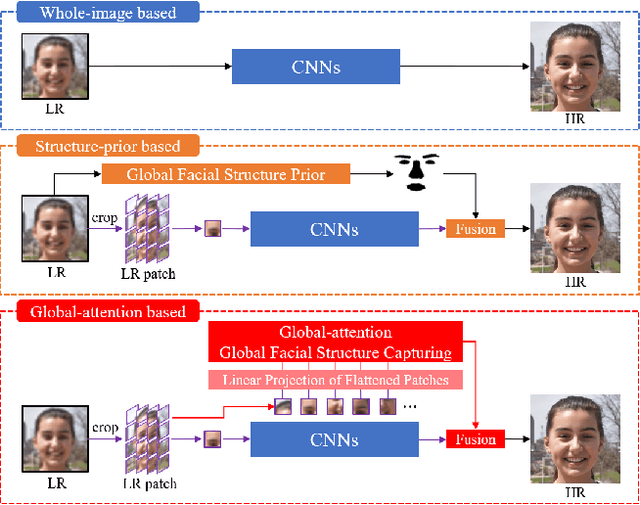


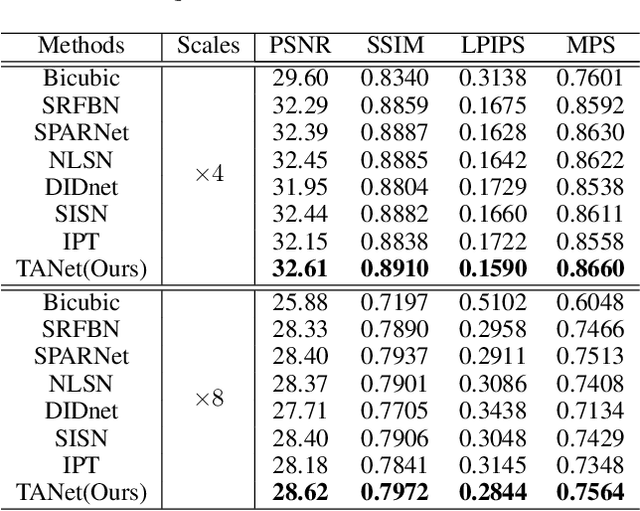
Abstract:Recently, face super-resolution (FSR) methods either feed whole face image into convolutional neural networks (CNNs) or utilize extra facial priors (e.g., facial parsing maps, facial landmarks) to focus on facial structure, thereby maintaining the consistency of the facial structure while restoring facial details. However, the limited receptive fields of CNNs and inaccurate facial priors will reduce the naturalness and fidelity of the reconstructed face. In this paper, we propose a novel paradigm based on the self-attention mechanism (i.e., the core of Transformer) to fully explore the representation capacity of the facial structure feature. Specifically, we design a Transformer-CNN aggregation network (TANet) consisting of two paths, in which one path uses CNNs responsible for restoring fine-grained facial details while the other utilizes a resource-friendly Transformer to capture global information by exploiting the long-distance visual relation modeling. By aggregating the features from the above two paths, the consistency of global facial structure and fidelity of local facial detail restoration are strengthened simultaneously. Experimental results of face reconstruction and recognition verify that the proposed method can significantly outperform the state-of-the-art methods.
Multi-scale Self-calibrated Network for Image Light Source Transfer
Apr 18, 2021



Abstract:Image light source transfer (LLST), as the most challenging task in the domain of image relighting, has attracted extensive attention in recent years. In the latest research, LLST is decomposed three sub-tasks: scene reconversion, shadow estimation, and image re-rendering, which provides a new paradigm for image relighting. However, many problems for scene reconversion and shadow estimation tasks, including uncalibrated feature information and poor semantic information, are still unresolved, thereby resulting in insufficient feature representation. In this paper, we propose novel down-sampling feature self-calibrated block (DFSB) and up-sampling feature self-calibrated block (UFSB) as the basic blocks of feature encoder and decoder to calibrate feature representation iteratively because the LLST is similar to the recalibration of image light source. In addition, we fuse the multi-scale features of the decoder in scene reconversion task to further explore and exploit more semantic information, thereby providing more accurate primary scene structure for image re-rendering. Experimental results in the VIDIT dataset show that the proposed approach significantly improves the performance for LLST.
Face Hallucination Using Split-Attention in Split-Attention Network
Oct 22, 2020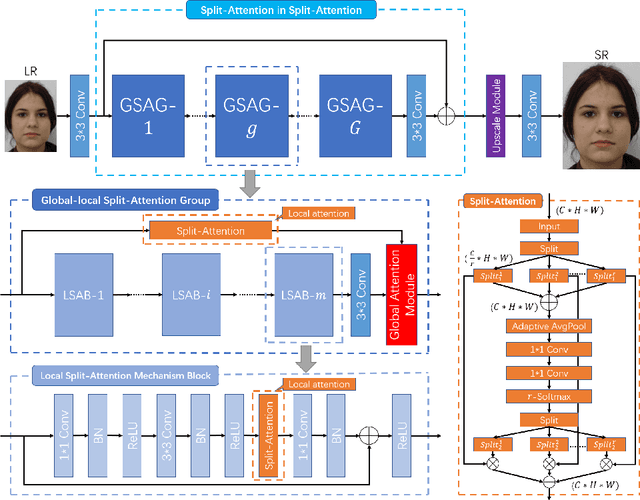


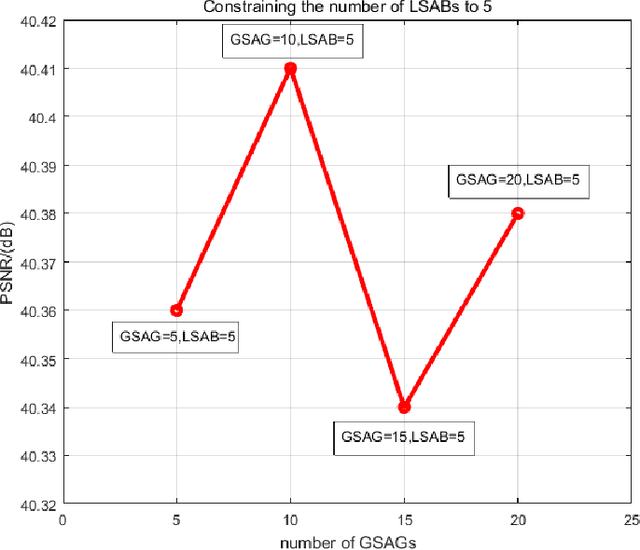
Abstract:Face hallucination is a domain-specific super-resolution (SR), that generates high-resolution (HR) facial images from the observed one/multiple low-resolution (LR) input/s. Recently, convolutional neural networks(CNNs) are successfully applied into face hallucination to model the complex nonlinear mapping between HR and LR images. Although global attention mechanism equipped into CNNs naturally focus on the facial structure information, it always ignore the local and cross feature structure information, resulting in limited reconstruction performance. In order to solve this problem, we propose global-local split-attention mechanism and design a Split-Attention in Split-Attention (SIS) network to enable local attention across feature-map groups attaining global attention and to improve the ability of feature representations. SIS can generate and focus the local attention of neural network on the interaction of face key structure information in channel-level, thereby improve the performance of face image reconstruction. Experimental results show that the proposed approach consistently and significantly improves the reconstruction performances for face hallucination.
 Add to Chrome
Add to Chrome Add to Firefox
Add to Firefox Add to Edge
Add to Edge